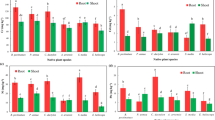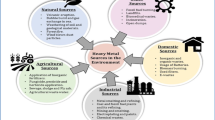Abstract
The aim of this study was to investigate the accumulation of boron (B) in the soils, sediments, and plants in the wastewater (treated and untreated) irrigation farmlands. Twelve sites of soils and four sites of sediments were collected in two wastewater irrigation areas of Tianjin, China. Our results show that the long-term irrigation of wastewater induced B accumulation in the soils (81 − 90 mg kg−1 on average) and sediments (112 − 150 mg kg−1 on average). The readily available B fractions, salt extractable B and water extractable B, accounted for more than half of the extractable B. The plant available B in the soils exceeded toxic levels of most sensitive crops but B in plant leaves did not reach the thresholds. This study indicates that long-term irrigation of wastewater would induce excess accumulation of B in the soils of the farmlands and might pose a toxicity risk to the plants.





Similar content being viewed by others
Availability of data and materials
Not applicable.
References
Alghobar, M. A., & Suresha, S. (2017). Evaluation of metal accumulation in soil and tomatoes irrigated with sewage water from Mysore city, Karnataka, India. Journal of the Saudi Society of Agricultural Sciences, 16(1), 49–59.
Arora, S., & Chahal, D. S. (2014). Forms of boron in alkaline alluvial soils in relation to soil properties and their contribution to available and total boron pool. Communications in Soil Science and Plant Analysis, 45(17), 2247–2257.
Bañuelos, G. S. (2002). Irrigation of broccoli and canola with boron- and selenium-laden effluent. Journal of Environmental Quality, 31(6), 1802–1808.
Blamey, F. P. C., Asher, C. J., & Edwards, D. G. (1997). Boron toxicity in sunflower. In R. W. Bell & B. Rerkasem (Eds.), Boron in Soils and Plants (pp. 145–149). Kluwer Academic Publishers.
Brdar-Jokanović, M., Maksimović, I., Kraljević-Balalić, M., Zeremski-Škorić, T., Kondić-Špika, A., & Kobiljski, B. (2013). Boron concentration vs. content as criterion for estimating boron tolerance in wheat. Journal of Plant Nutrition, 36(3), 470–480.
Cervilla, L. M., Blasco, B., Rios, J. J., Rosales, M. A., Sánchez-Rodríguez, E., Rubio-Wilhelmi, M. M., Romero, L., & Ruiz, J. M. (2012). Parameters symptomatic for boron toxicity in leaves of tomato plants. Journal of Botany, 726206.
Chatzissavvidis, C., & Antonopoulou, C. (2020). Boron toxicity in fruit crops: Agronomic and physiological implications. In A. K. Srivastava & C. Hu (Eds.), Fruit Crops: Diagnosis and Management of Nutrient Constraints (pp. 211–221). Elsevier.
Edelstein, M., Ben-Hur, M., & Plaut, Z. (2007). Grafted melons irrigated with fresh or effluent water tolerate excess boron. J Am Soc Hortic, 132(4), 484–491.
Gu, J., Deng, G., Zhang, J., Yao, L., Song, J., Zhang, Y., & Sun, J. (2007). Analysis of speciation of boron in the boron sludge. Metall Anal, 27(10), 65–68. (in Chinese with English abstract).
Hu, H., & Brown, P. H. (1997). Absorption of boron by plant roots. Plant and Soil, 193(1), 49–58.
Hua, T., Zhang, R., Sun, H., & Liu, C. (2021). Alleviation of boron toxicity in plants: Mechanisms and approaches. Critical Reviews in Environment Science and Technology, 51(24), 2975–3015.
Ilyas, M., Mahmood, T., Ali, A., Babar, M., Rasheed, A., & Mujeeb-Kazi, A. (2015). Characterization of D-genome diversity for tolerance to boron toxicity in synthetic hexaploid wheat and in silico analysis of candidate genes. Acta Physiologiae Plantarum, 37, 17.
Jin, J. Y., Martens, D. C., & Zelazny, L. W. (1987). Distribution and plant availability of soil boron fractions. Soil Science Society of America Journal, 51(5), 1228–1231.
Johnson, G. V., & Fixen, P. E. (1990). Testing soils for sulfur, boron, molybdenum, and chlorine. In R. L. Westerman (Ed.), Soil Testing and Plant Analysis (3rd ed., pp. 265–273). Soil Science Society of America Inc.
Katsikantami, I., Colosio, C., Alegakis, A., Tzatzarakis, M. N., Vakonaki, E., Rizos, A. K., Sarigiannisde, D. A., & Tsatsakis, A. M. (2019). Estimation of daily intake and risk assessment of organophosphorus pesticides based on biomonitoring data–the internal exposure approach. Food and Chemical Toxicology, 123, 57–71.
Keren, R., & Bingham, F. T. (1985). Boron in water, soils, and plants. In B. A. Stewart (Ed.), Advances in Soil Science (Vol. 1, pp. 229–276). Springer.
Koç, C. (2007). Effects on environment and agriculture of geothermal wastewater and boron pollution in Great Menderes Basin. Environmental Monitoring and Assessment, 125(1), 377–388.
Li, C., Cao, J., Yao, L., Wu, Q., & Lv, J. (2020). Pollution status and ecological risk of heavy metals in the soils of five land-use types in a typical sewage irrigation area, eastern China. Environmental Monitoring and Assessment, 192, 471.
Li, J. L., Wang, Y. X., Zhang, C. X., Dong, Y. H., Du, B., & Liao, X. P. (2014). The source apportionment of polycyclic aromatic hydrocarbons (PAHs) in the topsoil in Xiaodian sewage irrigation area, North of China. Ecotoxicology, 23(10), 1943–1950.
Li, P., Wang, X., Allinson, G., Li, X., & Xiong, X. (2009). Risk assessment of heavy metals in soil previously irrigated with industrial wastewater in Shenyang, China. Journal of Hazardous Materials, 161(1), 516–521.
Li, X., Li, P., Lin, X., Gong, Z., Fan, S., Zheng, L., & Verkhozina, E. A. (2008). Spatial distribution and sources of polycyclic aromatic hydrocarbons (PAHs) in soils from typical oil-sewage irrigation area, Northeast China. Environmental Monitoring and Assessment, 143(1), 257–265.
Liu, S., Zheng, H., Ding, F., & Wang, G. (2009). The sensibility of 18 vegetable species to boron toxicity. Journal of Agro-Environmental Science, 28(10), 2017–2022. (in Chinese with English abstract).
Lucho-Constantino, C. A., Prieto-García, F., Del Razo, L. M., Rodríguez-Vázquez, R., & Poggi-Varaldo, H. M. (2005). Chemical fractionation of boron and heavy metals in soils irrigated with wastewater in central Mexico. Agriculture, Ecosystems & Environment, 108(1), 57–71.
Mandal, B., & De, D. K. (1993). Depthwise distribution of extractable boron in some acidic Inceptisols of India. Soil Science, 155(4), 256–262.
Mendoza-Grimón, V., Fernández-Vera, J. R., Hernández-Moreno, J. M., & Palacios-Díaz, M. D. P. (2019). Sustainable irrigation using non-conventional resources: What has happened after 30 years regarding boron phytotoxicity? Water, 11(9), 1952.
Meng, W., Wang, Z., Hu, B., Wang, Z., Li, H., & Goodman, R. C. (2016). Heavy metals in soil and plants after long-term sewage irrigation at Tianjin China: A case study assessment. Agricultural Water Management, 171, 153–161.
Mohan, T. C., & Jones, A. M. (2018). Determination of boron content using a simple and rapid miniaturized curcumin assay. Bio-protocol, 8(2). https://doi.org/10.21769/BioProtoc.2703
Nable, R. O., Bañuelos, G. S., & Paull, J. G. (1997). Boron toxicity. Plant and Soil, 193(1), 181–198.
Niaz, A., Ahmad, W., Zia, M. H., & Malhi, S. S. (2013). Relationship of soil extractable and fertilizer boron to some soil properties, crop yields, and total boron in cotton and wheat plants on selected soils of Punjab, Pakistan. Journal of Plant Nutritrion, 36(3), 343–356.
Oertli, J. J., & Kohl, H. C. (1961). Some considerations about the tolerance of various plant species to excessive supplies of boron. Soil Science, 92(4), 243–247.
Padbhushan, R., & Kumar, D. (2017). Fractions of soil boron: A review. Journal of Agricultural Science, 155(7), 1023–1032.
Qi, W., Cao, J., Chen, Y., & Qi, P. (1991). Research of boron background value in soil environments. Arid Environmental Monitoring, 5(3), 140–143. (in Chinese with English abstract).
Ranjbar, F., & Jalali, M. (2013). Release kinetics and distribution of boron in different fractions in some calcareous soils. Environment and Earth Science, 70(3), 1169–1177.
Reid, R. J. (2013). Boron toxicity and tolerance in crop plants. In N. Tuteja & S. S. Gill (Eds.), Crop improvement under adverse conditions (pp. 333–346). Springer, New York.
Ren, S., Shao, Y., Gao, B., & Wang, F. (2006). Effects of long-term located fertilization on the available boron content of soil. Chinese Journal of Eco-Agriculture, 14(3), 56–57. (in Chinese with English abstract).
Sarkar, D., Mandal, B., Kundu, M. C., & Bhat, J. A. (2008). Soil properties influence distribution of extractable boron in soil profile. Communications in Soil Science and Plant Analysis, 39(15–16), 2319–2332.
Shani, U., Dudley, L. M., & Hanks, R. J. (1992). Model of boron movement in soils. Soil Science Society of America Journal, 56(5), 1365–1370.
Sidhu, G. S., & Kumar, D. (2018). Influence of soil applied boron on yield of berseem (Trifolium alexandrium L.) and soil boron fractions in calcareous soils. Journal of Plant Nutrition, 41(8), 980–995.
Singh, A. L., Jat, R. S., Chaudhari, V., Bariya, H., & Sharma, S. J. (2010). Toxicities and tolerance of mineral elements boron, cobalt, molybdenum and nickel in crop plants. Plant Stress, 4(2), 31–56.
Tassi, E. L., Pedron, F., & Barbafieri, M. (2011). Evaluating the absorption of boron by plants—A potential tool to remediate contaminated sediments from Cecina River Basin in Italy. Water, Air, and Soil Pollution, 216(1), 275–287.
Tlili, A., Dridi, I., Attaya, R., & Gueddari, M. (2019). Boron characterization, distribution in particle-size fractions, and its adsorption-desorption process in a semiarid Tunisian soil. Journal of Chemistry. https://doi.org/10.1155/2019/2508489
Tsadilas, C. D. (1997). Soil contamination with boron due to irrigation with treated municipal waste water. In R. W. Bell & B. Rerkasem (Eds.), Boron in Soils and Plants (pp. 265–270). Kluwer Academic Publishers.
Wei, L., Ding, Q., Guo, H., Xiu, W., & Guo, Z. (2021). Forms and mobility of heavy metals/metalloids in sewage-irrigated soils in the North China Plain. Journal of Soils and Sediments, 21(1), 215–234.
World Health Organization. (1996). Boron. In Trace elements in human nutrition and health (pp. 175–179). Geneva.
Yao, H., Zhang, S., Xue, X., Yang, J., Hu, K., & Yu, X. (2013). Influence of the sewage irrigation on the agricultural soil properties in Tongliao City, China. Frontiers of Environmental Science & Engineering, 7(2), 273–280.
Zhang, Y. L., Dai, J. L., Wang, R. Q., & Zhang, J. (2008). Effects of long-term sewage irrigation on agricultural soil microbial structural and functional characterizations in Shandong, China. European Journal of Soil Biology, 44(1), 84–91.
Zhu, D., Juan, W., Liao, S., & Liu, W. (2007). Relationship between plant availability of boron and the physico-chemical properties of boron in soils. In F. Xu, H. E. Goldbach, P. H. Brown, R. W. Bell, T. Fujiwara, G. D. Hunt, & S. Goldberg (Eds.), Advances in plant and animal boron nutrition (pp. 345–354). Springer.
Zhu, H., Cheng, R., Bañuelos, G., & Centofanti, T. (2019). Feasibility of growing halophyte “agretti” (Salsola soda) as an alternative boron-tolerant food crop in unproductive boron-laden regions. Plant and Soil, 445, 323–334.
Acknowledgements
We thank Xiaojiao He at the College of Environmental Science and Engineering, Nankai University for the laboratory assistance.
Funding
This work was supported by the National Key Research and Development Project of China (2019YFC1804403), the National Natural Science Foundation of China (42177373), the Natural Science Foundation of Tianjin, China (19JCYBJC24000), and the Ministry of Education of China (T2017002).
Author information
Authors and Affiliations
Contributions
Qian Zhao contributed to sample collection and determination and prepared the manuscript draft. Rui Zhang performed data analysis. Lei Wang contributed to the draft revision. Hongwen Sun contributed to the conception and design. Chunguang Liu supervised the study and revised the manuscript.
Corresponding author
Ethics declarations
Ethics approval and consent to participate
No medical or animal experiments have been conducted, so ethics approval is not applicable. We affirm that all authors have participated in the research work and are fully aware of ethical responsibilities.
Consent for publication
We affirm that all authors have agreed for the submission of the paper to EMAS and are fully aware of ethical responsibilities.
Competing interests
The authors declare no competing interests.
Additional information
Publisher's Note
Springer Nature remains neutral with regard to jurisdictional claims in published maps and institutional affiliations.
Supplementary Information
Below is the link to the electronic supplementary material.
Rights and permissions
Springer Nature or its licensor (e.g. a society or other partner) holds exclusive rights to this article under a publishing agreement with the author(s) or other rightsholder(s); author self-archiving of the accepted manuscript version of this article is solely governed by the terms of such publishing agreement and applicable law.
About this article
Cite this article
Zhao, Q., Zhang, R., Wang, L. et al. Boron accumulation in soil, sediment, and plant of wastewater-irrigated areas in Tianjin, China. Environ Monit Assess 195, 110 (2023). https://doi.org/10.1007/s10661-022-10723-3
Received:
Accepted:
Published:
DOI: https://doi.org/10.1007/s10661-022-10723-3




